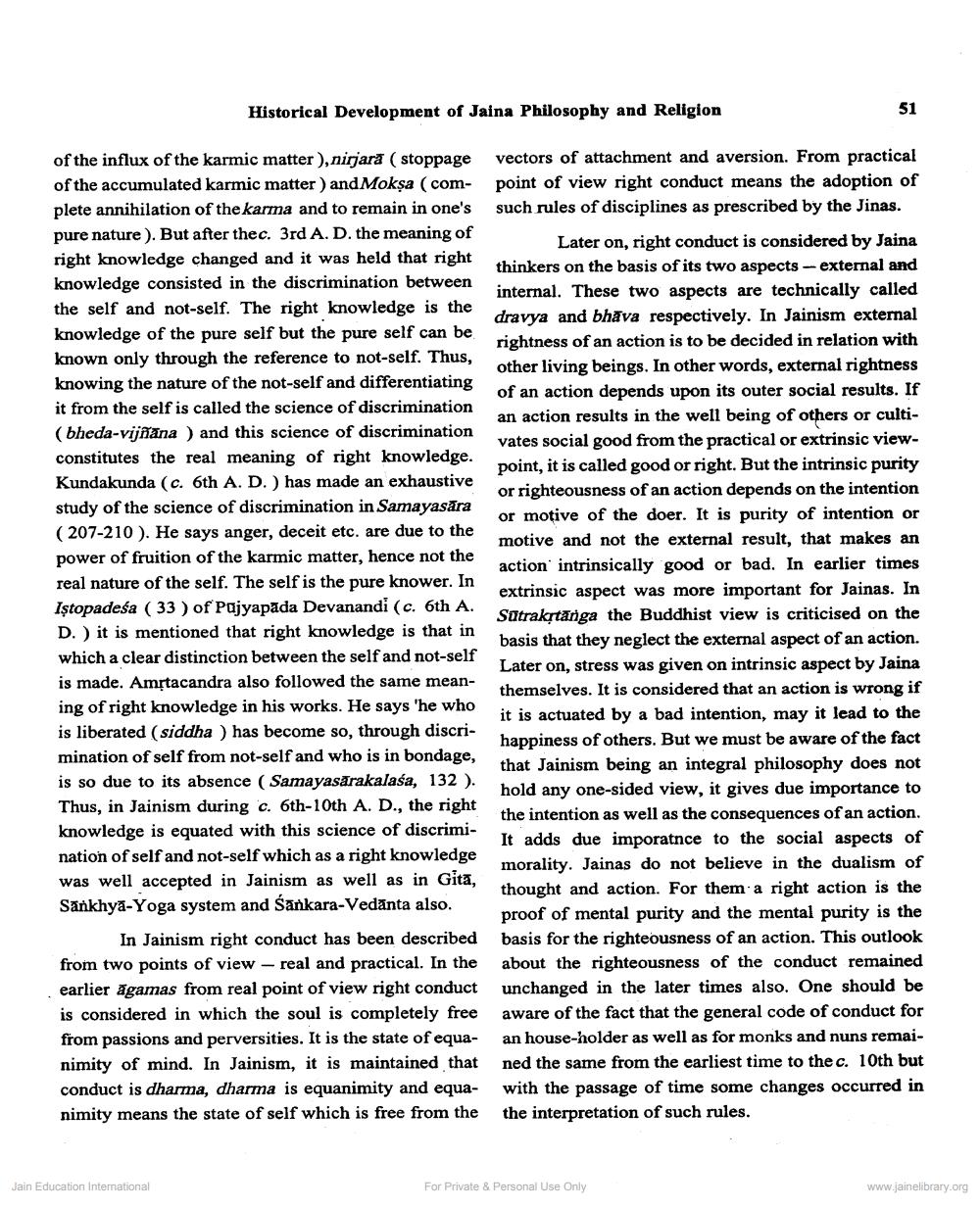________________
Historical Development of Jaina Philosophy and Religion
51
vectors of attachment and aversion. From practical point of view right conduct means the adoption of such rules of disciplines as prescribed by the Jinas.
of the influx of the karmic matter ), nirjara ( stoppage of the accumulated karmic matter ) and Mokșa (com- plete annihilation of the karma and to remain in one's pure nature ). But after thec. 3rd A. D. the meaning of right knowledge changed and it was held that right knowledge consisted in the discrimination between the self and not-self. The right knowledge is the knowledge of the pure self but the pure self can be known only through the reference to not-self. Thus, knowing the nature of the not-self and differentiating it from the self is called the science of discrimination (bheda-vijnana ) and this science of discrimination constitutes the real meaning of right knowledge. Kundakunda (c. 6th A. D.) has made an exhaustive study of the science of discrimination in Samayasara ( 207-210 ). He says anger, deceit etc. are due to the power of fruition of the karmic matter, hence not the real nature of the self. The self is the pure knower. In Istopadeśa ( 33 ) of Pajyapāda Devanandi (c. 6th A. D.) it is mentioned that right knowledge is that in which a clear distinction between the self and not-self is made. Amrtacandra also followed the same meaning of right knowledge in his works. He says the who is liberated (siddha ) has become so, through discrimination of self from not-self and who is in bondage, is so due to its absence (Samayasarakalasa, 132 ). Thus, in Jainism during c. 6th-10th A. D., the right knowledge is equated with this science of discrimination of self and not-self which as a right knowledge was well accepted in Jainism as well as in Gita, Sankhya-Yoga system and Sankara-Vedānta also.
In Jainism right conduct has been described from two points of view – real and practical. In the earlier agamas from real point of view right conduct is considered in which the soul is completely free from passions and perversities. It is the state of equa- nimity of mind. In Jainism, it is maintained that conduct is dharma, dharma is equanimity and equa- nimity means the state of self which is free from the
Later on, right conduct is considered by Jaina thinkers on the basis of its two aspects - external and internal. These two aspects are technically called dravya and bhāva respectively. In Jainism external rightness of an action is to be decided in relation with other living beings. In other words, external rightness of an action depends upon its outer social results. If an action results in the well being of others or cultivates social good from the practical or extrinsic viewpoint, it is called good or right. But the intrinsic purity or righteousness of an action depends on the intention or motive of the doer. It is purity of intention or motive and not the external result, that makes an action' intrinsically good or bad. In earlier times extrinsic aspect was more important for Jainas. In Sutrakytanga the Buddhist view is criticised on the basis that they neglect the external aspect of an action. Later on, stress was given on intrinsic aspect by Jaina themselves. It is considered that an action is wrong if it is actuated by a bad intention, may it lead to the happiness of others. But we must be aware of the fact that Jainism being an integral philosophy does not hold any one-sided view, it gives due importance to the intention as well as the consequences of an action. It adds due imporatnce to the social aspects of morality. Jainas do not believe in the dualism of thought and action. For them a right action is the proof of mental purity and the mental purity is the basis for the righteousness of an action. This outlook about the righteousness of the conduct remained unchanged in the later times also. One should be aware of the fact that the general code of conduct for an house-holder as well as for monks and nuns remained the same from the earliest time to the c. 10th but with the passage of time some changes occurred in the interpretation of such rules.
so.
Jain Education International
For Private & Personal Use Only
www.jainelibrary.org




